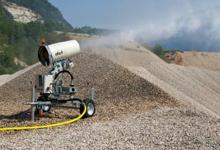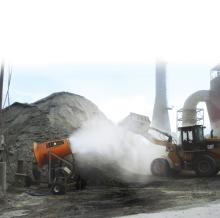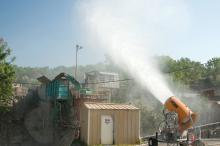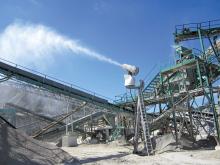
Controlling dust is becoming increasingly important for quarry operators but they are helped by the wide range of solutions available says Lisa Russell
There are many opportunities for disturbed material to take to the air in the quarrying process while it is being blasted, crushed, screened, transported and stored. Technology continues to develop to provide more efficient control of the dust but it really all boils down to some basic principles.
"There are only three ways that you can manage dust," said
While it certainly isn't practical to contain an entire quarry, parts of the process can be enclosed quite easily. Collection may be the best solution in some situations through use of electrostatic precipitators, suction systems, cyclones and filters. The third approach, suppression, puts tiny water particles in the atmosphere and these attract the dust, which then drops to the ground.
There is a widespread belief that pressures will increase for quarries to do more to counter dust to avoid environmental issues for people living nearby. "As cities grow, they grow towards the quarries - and the quarries get bigger as well," sums up Thomas Ossevorth,
Dust can be an issue right from extraction through all stages to storage and transfer off site, said
Operational management can also play a part in avoiding nuisance said SLR Consulting technical director Matt Stoaling. Ideally, blasting will be avoided when the wind is in a direction that would drive dust to a nearby receptor.
Peterson said that the Pareto principle (or 80-20 rule) applies to quarry dust generation. "Eighty percent of the dust in a given quarry is generated by 20% of the sources," he said. He advises operators to use this principle to guide them into a general understanding of where most dust is generated. "This gives you the ability to identify and isolate those key areas and then prioritise spending for the greatest return."
"We should separate the dusts into two categories - harmful and useful - but both of them are dangerous when they freely circulate in the atmosphere," he said. And while the dry dust must be filtered, it can then be recycled if appropriate.
Dust control warrants more than 50 pages of coverage in a book about bulk materials handling by DCT's sister company
A combination of legislation and local planning conditions drives the greater focus on dust suppression. Legislation primarily affects the very fine dust that builds up in the respiratory system and harms health, but uncontrolled dust can also create a nuisance.
"Everybody is more focused on environmental quality," said Stoaling. There are more local action groups in communities around quarries, and quarry managers increasingly need to communicate well with people nearby.
Areas of development include automation, said
Electrostatic systems and suction are among the means used to gather dust right down to the finest particles. Single suction systems may be mounted at transfer points, or centralised systems may be used to suck air through pipework to a central filter. An electrostatic system gathers the airborne dust before returning it to the conveyor. Sandvik's HX410 system sits at transfer points where dust is generated as the material hits the next belt. Electrostatic forces inside the housing cause the dust to be deposited there then an unbalanced motor runs periodically for about 10 seconds to shake off the dust onto the conveyor. Research by Sandvik in a quartz sand production facility showed suppression rates of between 86.8% and 96.3% for two sizes of respirable dust, including those particles fine enough to penetrate the alveoli.
"The main technology that people seem to be focused on is bringing out new ideas based on water irrigation systems," said Cutler. Traditional tractor and bowser methods use water in large droplets, with high consumption and run-off. In contrast, atomised sprays dispense tiny droplets at high velocities over a large area. "These smaller droplets catch the dust particles and drive them back to the ground."
Suppression using water is an important approach for bringing down airborne dust and is ideal for many situations, and using a mist means that the water volumes can be kept low. Dust particles are swept around large drops of water but will readily join droplets of similar size to themselves, explains Peterson. Water-based suppression can come from units that are portable or mounted in a fixed position. New technologies include more self-contained units and greater use of automation, he said. DCT's
Automation means that systems can be triggered by wind direction and windspeed, said Fritz. Mobile units are generally controlled remotely or on the unit while the fixed systems on towers or other supports may be controlled automatically by computer.
"The closer you work to the source, the more chance you have to be efficient and suppress most of the dust," he said. "If you are too far away, the dust disperses and it is more difficult to lay it down." Nozzles can be tailored to suit a specific application and TechnoAlpin's latest mobile model allows the user to select the size of the droplets and water flows to adapt to the immediate situation.
While water is often used to damp down the material, this isn't always appropriate. It could for instance clog up a screen or make material stick to belts and rollers. Furthermore, water is unavailable in some quarries. But shaking screens emit a lot of dust. "The only thing you can do to counteract that is to encapsulate the whole screen," said Ossevorth.
There are no real challenges in keeping dust under control, said Aydoğdu: the main challenge is the cost pressure. He said that the lowest-priced dust collecting method is the backhouse or dry-type filtering system. It is widely used and the technology continues to develop through efforts to decrease running costs. He feels that quarries can best keep dust under control with backhouse filtering systems, seeing them as more appropriate solution than spraying water on the dust.
One way of countering dust generation when creating stockpiles is to ensure that chutes terminate close to the top of the piles. Sandvik produces a telescopic chute with a sensor that ensures the end is no more than a metre from the top of the pile.
Some quarries already achieve almost 100% dust control, believes Ossevorth, but many others could reduce their dust emissions by about 50%, though it could be quite expensive to do. He said that typical quarries in Germany have been suffering from a lack of money available for investment in recent years. "They only do something if they are forced to," he feels.











